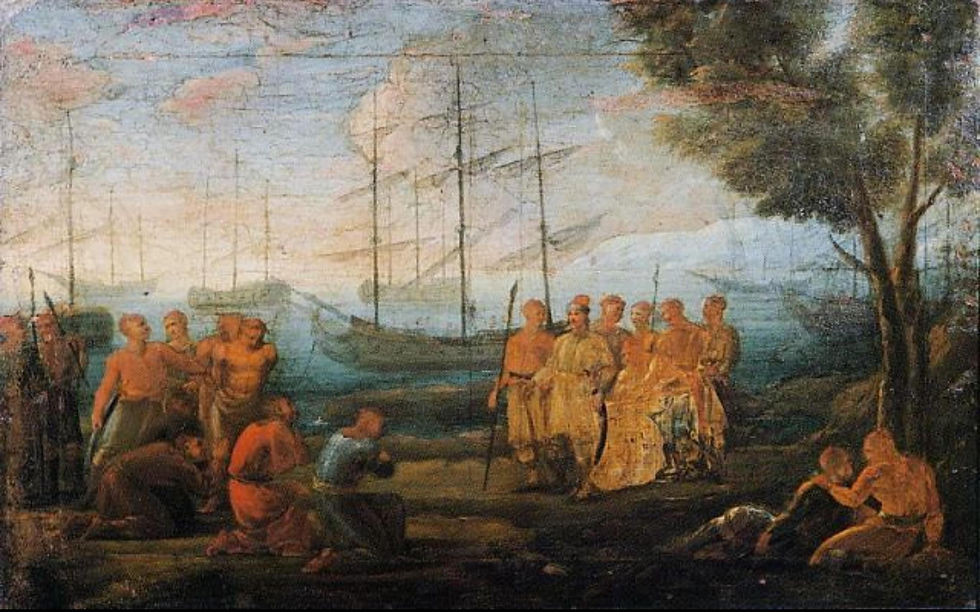D - 60: The Precious World of Tin and Silver
- hbanziger
- May 19, 2020
- 4 min read
Updated: Mar 26, 2021
Ended my last blog with the question why the mariners of ancient Phoenicia and Greece ventured west despite the risk of sailing into the unknown with hardly any technology. All they had was knowing how to read the stars and following the winds. What fortunes pulled these men and women westward? It must have been a profitable opportunity given the many prosperous colonies they established. In Spain alone the Phoenicians founded Cadiz, Cartagena, Almunecar, Malaga, Huelva and Ibiza.
The Phoenicians came first as traders. Very few weapons were found in their settlements and most were barely fortified. They wanted to exchange goods not colonise or occupy. But what goods were they looking for?

Map of known tin deposits around 1’000 BC
The Phoenicians came for tin, the metal necessary to make bronze with copper. Bronze requires 9 parts copper and one part of tin. Whilst copper has been cast since 9’000 BC, the much stronger bronze alloy was only discovered at around 3’500 BC. Due to its strength and ease of manufacturing, it became the metal of choice for the powerful states in the Fertile Crescent. Sumer, Babylon, the Assyrian dynasties and the Egyptian Pharaohs - all of them desired it to equip their large armies. Arrow heads, spears, swords, chariots, helmets and body armour - all were made from bronze. No regional superpower could exist without it. Trouble was that whilst copper was abundant in Cyprus and Anatolia, tin was rare and came from fare-away Afghanistan. The Indus states and the Sumer could control its supply and often cornered the market. Thus states bordering the Mediterranean looked for tin supply from the west. And guess who had tin? Spain and Cornwalls. How people found out is anyone’s guess. Soon after 1'500 BC tin was shipped regularly from Spain and Cornwalls to the Middle East. Recent archeological digs in Israel found tin Ingots from Cornwalls dating back to 1’300 BC.
But the scarcity of tin triggered another revolution which eventually ended the Bronze Age. People learned how to melt iron ore which was more easily to source. By around 1’000 BC, the Iron Age had started and bronze was quickly replaced as weapon of choice. Steel which could be welded from iron by adding around 2 % carbon, was stronger and more flexible, Steel provided battle field superiority, Any warrior with a steel sword could break and cut bronze swords easily. So just as the Phoenicians discovered the ample supply of tin in the west, the Bronze Age ended. What were they going to do?

Antique bronze household utensil (Imperial Roman Time)
Luckily, just as the demand for weaponised bronze declined, households started to discover its utility for domestic use. Pots, cutlery, goblets, plates, hair needles and much ore could be made from it. An even bigger market was created. Bronze found its way everywhere into daily life, even into the dressing room of wealthy ladies who used highly polished bronze mirrors. The alloy had found its retail market!

The Rio Tinto close to Huelva in Spain - the waters are acidic and full of naturally dissolved iron and heavy metals
But the Phoenicians found something even more precious in their tin mines up the river Rio Tinto - yes, the river that gave today’s giant mining conglomerate its name. They found silver! And they found it exactly at a time when the Assyrians made silver their currency. Money as such was invented by the Lydian Kingdom who used gold coins to pay its army. But there was not enough gold to base a currency. Thus the easier available silver was used. Silver to gold traded around the Mediterranean for two thousand years at a ratio of 1 part gold = 12 - 14 parts of silver. The Phoenicians became the silver suppliers to the Assyrian Kings who gracefully respected the independence of the Phoenician coastal towns provided they paid the annual silver tribute they were supposed to pay …

Assyrian silver horse

Silver promissory notes in cuneiform - the Phoenicians later simplified the book keeping by creating the first linguistic alphabet
It was the beginning of the massive flow of silver from West to East. Due to its geological make-up, Europe is relatively rich in silver but poor in gold. Asia is just the contrary. There is more gold than silver. As a consequence, for Millennia silver was more valuable in China and India than in Europe. The exchange ratio in Asia hovered around 1 part of gold = 6 -7 parts of silver.

The Ptolemaic Empire - linking east and west into one single big trading system
I always wondered how the traders from Ptolemaic Egypt who travelled to India by 300 BC paid for the spices, jewellery and silk from then still unknown China. The answer is simple: in silver. Over the next 2’000 years Asia would absorb most of the world’s silver production which provided the metal for their currency. Nobody has a precise number of how much silver went east but it must have billions of bullions. And it was the best arbitrage trade ever. One kilo of silver bought twice the amount of gold than in Europe. This trade alone with a guaranteed profit margin of 100% was worth sailing to Asia.
But this is part of another story - tomorrow we continue with how the Phoenician towns could survive in North Africa which is mostly desert now.







Comments